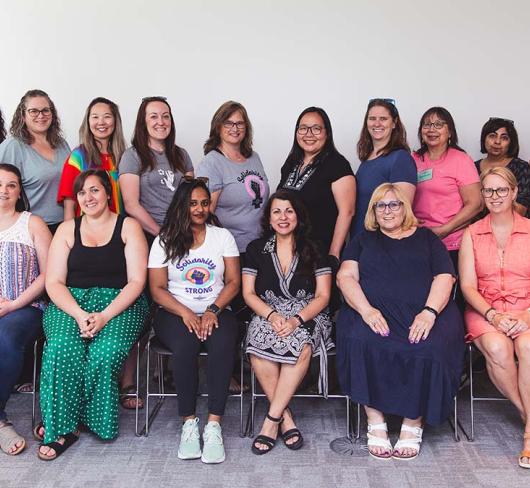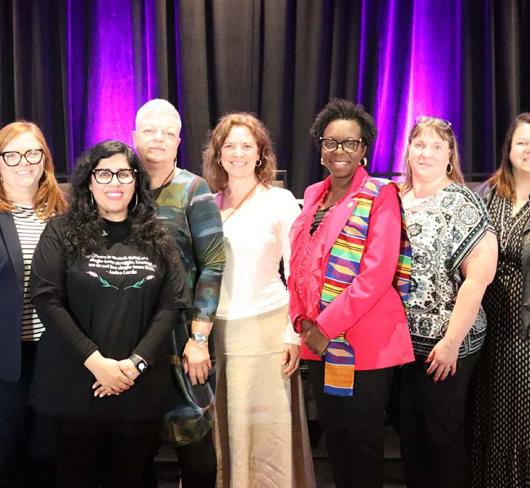
Looking Back: Women's History in Ontario Teacher Federations
Excerpted by Mary Morison from “It’s Elementary: A Brief History of Public Elementary Teachers and Their Federations.” Barbara Richter, ETFO, 2008.
Eighty-one percent of the members of the Elementary Teachers’ Federation of Ontario (ETFO) are women and, in many ways, the history of women teachers reflects the struggles of all Canadian women. Women in the paid workforce face challenges. They get pregnant. They do more work at home including child care and elder care. They are more vulnerable to violence and harassment at home and at work. And they are underrepresented in positions of power – in boardrooms, legislatures, courtrooms, union governing bodies and school boards. That was true 150 years ago and remains true today.
Women have made up the majority of elementary public school teachers since 1880, but their initial acceptance into teaching some 40 years earlier was the subject of controversy. In the 1840s, options for women who wanted or needed to work outside the home were limited mainly to what were considered subordinate or nurturing roles – domestic service, factory work, nursing. In 1865, Egerton Ryerson, an educator, politician and public education advocate in early Ontario, wrote that women were “best adapted to teach small children, having, as a general rule, most heart, most tender feelings, most assiduity, and, in the order of Providence, the qualities best suited for the care, instruction and government of infancy and childhood.”
Since teachers of younger children were paid less, boards could save money by hiring young women for primary classes while offering higher salaries to men teaching higher grades. When men married they received bonuses or promotions; when women married they were told to go home. Their limited time in the workforce meant women accrued fewer increments, exercised less influence and had fewer opportunities for advancement.
Feminism ’s First Wave – Women Teachers Begin to Organize!
Increased immigration, industrialization and urbanization brought changes to Canada’s social structure in the latter half of the 19th century. Women started to organize.
The “first wave” of feminism, the suffrage movement, helped open the doors for women to universities and the professions, and resulted in women winning the right to vote in 1918.
In 1888, eight women formed the Lady Teachers’ Association of Toronto, later called the Women Teachers’ Association (WTA) of Toronto. The group’s aims were “the social and mutual benefit of its members, the advancement of the interests of the Toronto lady teachers and the profession generally.” The WTA established a sick leave fund and worked for better salaries. Women teachers in London, Galt, Ottawa, Peterborough, Hamilton, Chatham, Port Arthur, St. Thomas, North Bay and Prescott formed similar associations.
On April 3, 1918, representatives from women’s teacher groups across the province formed the Federation of Women Teachers’ Associations of Ontario (FWTAO) “to promote the professional and financial status of women teachers.”
Early Militancy
In the first year of its existence, more than one third of women elementary teachers – 4,236 out of a total of 11,359 – joined FWTAO.
In 1919, they set $650 as the minimum salary and urged their colleagues not to undercut others by accepting lower pay. They believed salary levels should increase with experience, and worked to put women’s issues before school trustees and other decision makers.
In 1922, when women teachers in Owen Sound threatened a strike, the board increased their maximum salary to $1,200. Not all women teachers were as successful. Many who called for higher pay met opposition not only from their boards but also from their male colleagues who claimed they deserved higher salaries because they taught older students, coached sports and had families to support.
But men with no dependents also received higher pay. Moreover, studies have shown that many women, although single, were supporting the family farm, elderly or disabled relatives or younger siblings.
The women’s early successes, in combination with a growing anti-union sentiment in the country, created a backlash. There was still ambivalence about women doing paid work. They didn’t fit society’s expectations that women be models of silent self-sacrifice. Newspaper editorialists who had once been supportive now called these women teachers radicals and socialists. Even former allies in the suffrage movement thought their teacher sisters were going too far.
These attitudes, a post-war recession and the 1929 stock market crash reversed many early successes.
Between 1930 and 1936, the pay of male teachers was cut by about 38 percent while the already lower salaries of women were cut by 55 percent. Women also experienced more job losses. In 1939, there were 1,486 more men teaching than 10 years earlier but 1,303 fewer women, a trend that would reoccur when enrolments declined in the 1970s.
Work and Marriage
WWII changed the attitudes to women’s work. As men joined the military, first single women, then married women, then married women with children, did their patriotic duty and entered the labour force. When the war ended and the men returned, women who had built airplanes, harvested crops, driven streetcars, run businesses and taught school, went home – either willingly or as a result of layoffs. The federal government cancelled childcare subsidies and barred married women from the civil service. Just as it had been their patriotic duty to enter the workforce during the war, it was now women’s duty to return to marriage and homemaking.
Married women teachers, however, benefitted from the post-war baby boom that created a teacher shortage. By 1951 some 28 percent of women teachers were married compared to five percent 10 years earlier. A few years later married women made up the majority of teachers.
Work and Pregnancy
Skyrocketing birthrates were the reason children filled elementary schools, but board administrators considered the sight of a pregnant teacher in a classroom scandalous. Most boards required women to resign when they became pregnant.
Women with children faced barriers when they wanted to return to work. Women who did get jobs were rehired at the bottom of the scale or offered part-time positions with little chance of full-time work. Many boards that did provide maternity leave would only reinstate a woman if a position was available.
Although statutory bargaining rights were years away, FWTAO took maternity leave to the bargaining table, proposing a modest plan with provisions for a leave, the right to return to work and reinstatement at the same pay level with increment and seniority.
It also lobbied the provincial government to address maternity leave. In December 1970 the Women’s Equal Opportunity Act was enacted. It provided for a statutory maternity leave of 17 weeks and barred discrimination on the basis of sex or marital status in hiring, firing, training and promotion.
The Second Wave of Feminism
The 1960s and 1970s saw a resurgence in feminism. The suffragists believed that once women had the right to vote they would have true equality. They were mistaken; equality in law does not by itself result in substantive equality. In spite of laws governing equal pay,
non-discrimination and pregnancy leave, women still faced systemic discrimination. Women’s groups formed across the country. With more access to education than their mothers, women in the 1960s were graduating from universities with new views about family and career. The contraceptive pill became available in 1960 and, although prescribing or distributing information about contraception was illegal in Canada until 1969, the pill gave women the freedom to control their childbearing and to plan their lives around education, career and family instead of just family.
Women’s groups joined together and called on the federal government to investigate the factors contributing to women’s inequality. In 1967, Prime Minister Pearson appointed the Royal Commission on the Status of Women in Canada. In 1970, the Commission made recommendations about education and training, maternity leave, birth control and abortion, improved pensions, women’s shelters, child care, family law reform and affirmative action.
Women in Education
Women elementary teachers generally found their working conditions were better than those of many other women workers. More than 50 years of action by their federation had given them employment rights, rights for married women, pregnancy leave. New bargaining legislation allowed them to negotiate improved rights for women. Now they began to talk about sexual harassment, protection from discrimination, improved working conditions, paid pregnancy and parental leaves and equal treatment for women in obtaining positions and promotions.
From Bright Beginnings to Harsh Realities
In the 1970s, the new generation of women teachers found their progress impeded by ceilings on school board expenditures, federal government wage and price controls and a decade-long period of declining enrolment.
The boards responded by making deep cuts, many disproportionately affecting women and young children. Boards attempted to replace junior kindergarten teachers with early childhood education graduates. They increased primary class sizes and introduced teaching assistants to handle the extra workload. Special education and ESL programs were slashed and libraries closed. In many boards, teacher-librarians were replaced by library technicians.
In 1975, new legislation gave federations the legal right to bargain collectively with boards. Teachers had been making great strides in obtaining salary improvements, winning significant double digit settlements to bring their salaries in line with those of other professional groups. Then, in October 1975, the federal government imposed wage and price controls. Many of the gains were rolled back and federation efforts diverted from their own issues to fighting to maintain the status quo.
In the 1970s, enrolments declined steeply resulting in an estimated loss of 5,500 elementary teaching positions. Old biases reappeared. Women who had been forced to resign before statutory maternity leave was enacted could not find work. Women who had accepted part-time assignments had no hope of gaining full-time work. Married women were pressured to reduce their hours, to resign or to retire early to make jobs available for others. Women were identified as surplus to system needs in greater numbers than their male colleagues. One board had 53 teachers on its redundancy list – all women. In another list of 200 redundant teachers, women outnumbered men by 9 to 1. At the beginning of the decade, 75 percent of elementary teachers were women; by 1980, it was 66.5 percent.
Equal Pay... Equal Value
In the debates around feminism, this question is often asked. It is 2016 after all. But women’s wages are still lower than those of men. Women still bear most of the responsibility for home care, child care and elder care. Women still experience violence and harassment on a daily basis – at home and at work.
The struggle for high quality accessible child care remains, and elementary education is still underfunded compared with secondary education.
Political power is still held predominantly by men. Although the federal cabinet is now half women, only 26 percent of Canadian legislators are women. At the present rate, it will take more than 200 years before women are represented equally with men in the Canadian House of Commons.
So the short answer is “yes.” Women’s issues are still issues for us all.
ETFO is committed to working for equity for all its members, 81 percent of whom are women. But no union, no federation, can achieve its goals without the active participation of its members. This history tells you about the past. The future is up to all of us.
Mary Morison is an executive staff member at ETFO.

